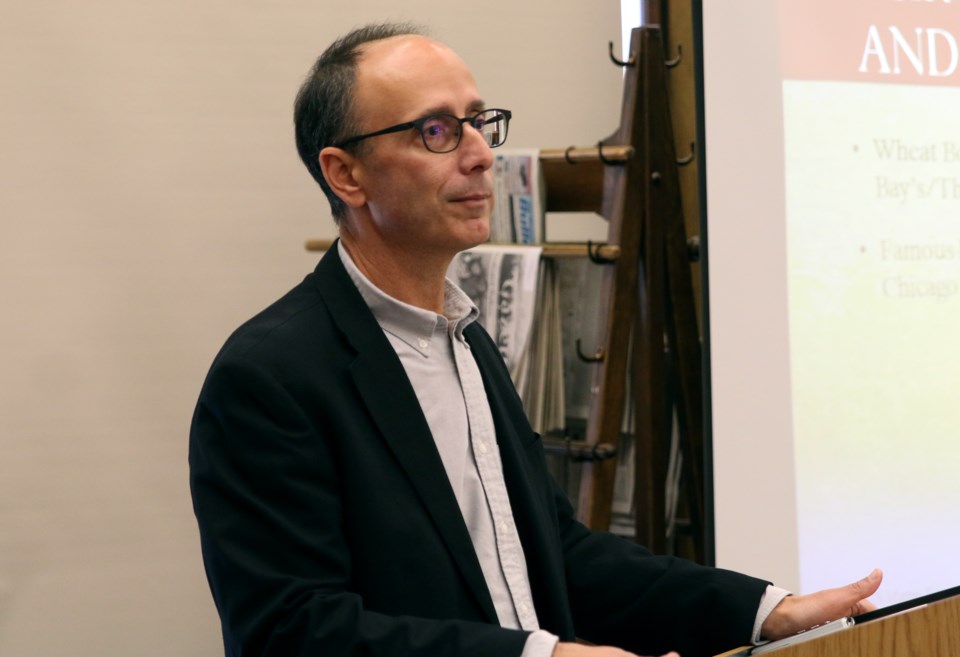THUNDER BAY - Once thought of as having the potential to be the Chicago of the north, Thunder Bay hasn’t lived up to what was probably an unrealistic expectation, and while the economy today has plateaued, there is still room for growth.
“That sentiment that somehow Thunder Bay was going to become the Chicago of the north was an aspiration that I think led to one of the disappointments of the 20th century and that people always felt we didn’t achieve as great a status or as great a development we could have and fell short of this mark,” said Livio Di Matteo, an economics professor at Lakehead University.
As part of Lakehead University’s In Conversation series, on Saturday Di Matteo provided a look Thunder Bay’s economy, from its time as one of the major metropolitan centres in Canada, to a levelling off today, and where it might be heading in the future.
The idea that the grain port on the shores of Lake Superior could one day rival Chicago came from Sir Wilfrid Laurier. While he may have said this at numerous stops along the campaign trail, Di Matteo said it was an unrealistic expectation because cities like Winnipeg, Minneapolis, and Toronto were already well established as major metropolitan areas.
But there were several reasons to be optimistic when it came to Port Arthur and Fort William during that time.
“If you go back to the glory days of Thunder Bay’s economy, if you went back to the grain boom era, this was a period where much of the infrastructure of the city was put in - ports, bridges, roads, and this was done to build up Thunder Bay as a grain port,” Di Matteo said.
However, a number of factors changed the economy in Thunder Bay. With a shift in world grain markets that focussed more on Asia as opposed to Eastern Europe, it became easier to export grain out of western Canada.
Labour saving technologies in the 1960s also slowed growth in some of the key economic pillars in Thunder Bay, such as forestry and transportaiton.
“If you went back 75 years, there was more private sector market activity driving the economy,” Di Matteo said. “The balance has swung to the public sector and quasi-public sector. About 30 per cent of employment is now public sector in one form or another.”
The amalgamation of Port Arthur and Fort William may have also played a role in slowing of the economy because the two municipal governments were more competitive and innovative then as a way to attract people to the respective cities.
“While the lack of cooperation between those entities was annoying and probably did not serve the marketing of the city well, the competition for economic activity, tax rates probably made it somewhat more of a dynamic place,” Di Matteo said.
Following the amalgamation, the population peaked and has remained flat ever since.
According to Di Matteo, the core pillars of the economy, such as forestry, transportation, and mining remain in place, but they are no longer the employment generators they once were. At its peak during the grain boom, the city’s population quadrupled, but that kind of growth seems unlikely now.
“For that kind of growth you need a substantial private sector wealth generating opportunity, something we export and the money comes in,” Di Matteo said. “But that does not seem to be on the horizon.”
Thunder Bay still has a diverse economy, but it is a slow-growth economy, according to Di Matteo, growing at about 1 to 1.5 per cent a year based on GDP, which is half the rate when compared to the rest of the country.
For Thunder Bay to see any kind of substantial growth in future, it is going to fall to those with entrepreneurial spirit.
“The best case scenario is a lot of the students that come here to study, people who grew up here and are coming back, will stay here and take up more entrepreneurial activities,” Di Matteo said. “I think that is where the future is going to be.”
Thunder Bay may not have become the Chicago of the north, but it can still remain on par with other centres of similar size, such as Duluth. It’s just going to take a little ingenuity in an economy that changed rapidly in 75 years.
“The future can also hold opportunity, but a lot of it requires entrepreneurial action, and I think that is one sector where we’ve been relatively weak,” Di Matteo said.
